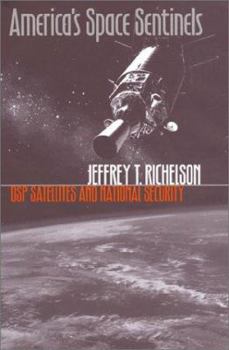America's Space Sentinels (PB)
Select Format
Select Condition 
Book Overview
Originally published in 1999, America's Space Sentinels won the American Astronautical Society's prestigious Eugene Emme Astronautical Literature Award and quickly established itself as the definitive... This description may be from another edition of this product.
Format:Paperback
Language:English
ISBN:0700610960
ISBN13:9780700610969
Release Date:March 2001
Publisher:University Press of Kansas
Length:330 Pages
Weight:1.14 lbs.
Dimensions:0.7" x 6.1" x 9.0"
Customer Reviews
3 ratings
Richelson Strikes again! Excellent coverage on a Great Topic!!
Published by Thriftbooks.com User , 17 years ago
Dr. Jeff Richelson has provided some of the greatest reads dealing with United States military satellite systems - "America's Secret Eyes in Space", "The US Intelligence Community", and now "America's Space Sentinels." This book covers the genesis and evolution of the US' space-based missile warning system, commonly known as DSP, or defense support program. Dr. Richelson takes us through the teething of MIDAS, Program 646, and DSP's early predecessors, in addition to its successors of ALERT and SBIRS. One high point in the text is the information on SCUD missile launches during Operation Desert Storm. While the news media reported bits and pieces on the launches, Dr. Richelson gives us a "bird's eye" view of what crews in Colorado saw half-a-world away, and what their contribution did to the defense of the US troops in the desert. The only downside to this book is its currency - This is a volume in definite need of updating due to the bringing online of the SBIRS constellation, the battles fought during the Clinton era about space systems and emerging technologies that have DSP/SBIRS ready for the scrap-heap. If you're a military space-nut like me, this needs to be in your library.
An Important Study of a Critical Military Space Program
Published by Thriftbooks.com User , 21 years ago
The Defense Satellite Program (DSP)-truly one of the most innocuous code names ever devised for a critical military program-arose in the earliest years of the space age as a means of detecting the launch of a rocket from anywhere in the world. With the development of ballistic missiles in the 1950s, for the first time in the history of the United States our two great oceans could not protect us from sustained attack and destruction. To warn against a Soviet ballistic missile attack, and thereby to allow time for the launch of a counterattack, the Department of Defense sponsored the development of satellites ringing the globe that would use infrared photographic technology to detect missile launches. The theory behind the system was that the heat signature from the rocket blast would be detected by satellites in space and then show up on infrared scopes at military monitoring posts. Through this process the time and place of launch, as well as the missile trajectory, could be ascertained within seconds of launch.It was a brilliant concept but it took years for it to come to fruition. The first effort, Project MIDAS, experienced numerous technical problems, but finally reached a turning point in 1963 when MIDAS 7 detected the first missile launch from space. MIDAS confirmed the concept, and the DSP program, with first launch in 1970, has provided early warning of missile launches ever since. Through 1997 eighteen DSP satellites had been placed in orbit, not all of them operational of course at the same time.Jeffrey T. Richelson's history of this program, "America's Space Sentinels," is an especially important and welcome addition to the literature of the military space program. It provides as comprehensive an understanding of this effort as is possible in the current environment, using a wealth of declassified documents to piece together this program's evolution from idea to implementation and operational life. It is, of course, not the final word on this subject because of still-classified materials that should one day be made available about DSP, but it represents a benchmark in the historiography.Especially welcome is Richelson's discussion of DSP's employment in the post-cold war era. He provides an excellent overview of its use to detect Scud missile launches in the Gulf War of 1991. He also describes how it detected the test firing of a new Iranian missile in 1998 and its use in piecing together the details of airplane accidents, such as the September 1997 collision of American and German military aircraft off the Atlantic coast of Africa. He ends with a discussion of the follow-on missile launch detection program, the Space-Based Infrared System (SBIRS), which is due to come on line at the end of the century.From the time when DSP served as the backbone of the nation's strategic early warning system during the cold war through its continued use in the still very threatening climate of the 1990s to its replacement by a presumably more capable
Excellent coverage of an Indispensible Satellite System
Published by Thriftbooks.com User , 25 years ago
This book gives an excellent overview of America's Missile Warning satellites, beginning with MIDAS in the 1960s and ending with SBIRS for the 21st Century. The information included in the text is more in-depth that the fact sheets given out by the United States Air Force.






